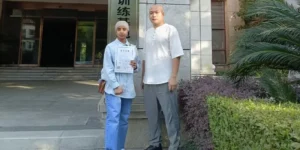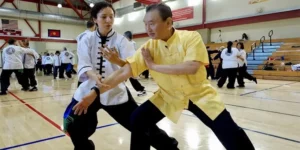Tai Chi Push Hands is a two-person practice originating from Taoism, designed to train the mind and body to respond to external forces with wisdom. But how exactly does it work?
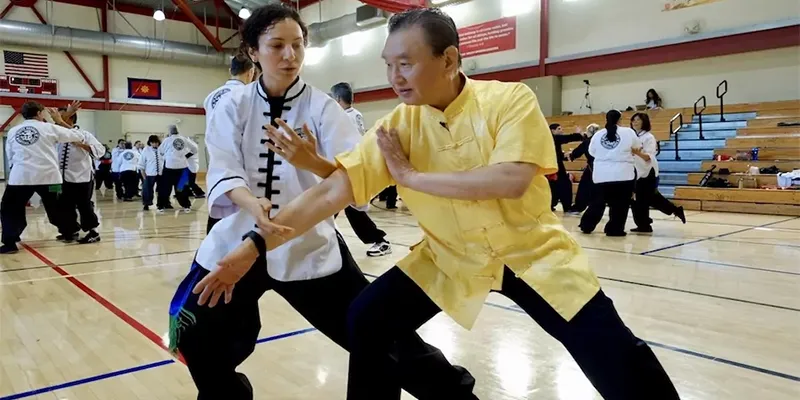
The core principle of pushing hands is the interaction of complementary forces. When one party pushes (yang), the other party follows the momentum (yin), guiding the force rather than resisting it.
Tai Chi Push Hand’s goal is to neutralize the incoming force while maintaining one’s own balance, achieving maximum effect with minimal effort. This principle is embodied in a Tai Chi proverb: “Using four ounces of force to withstand a thousand-pound burden.”
How Does Tai Chi Push Hands Work?
Listening (Ting Jin)
The first and most critical skill in push hands is “listening.” This does not refer to auditory listening, but rather to cultivating an extremely keen “tactile sense” through contact with your opponent.
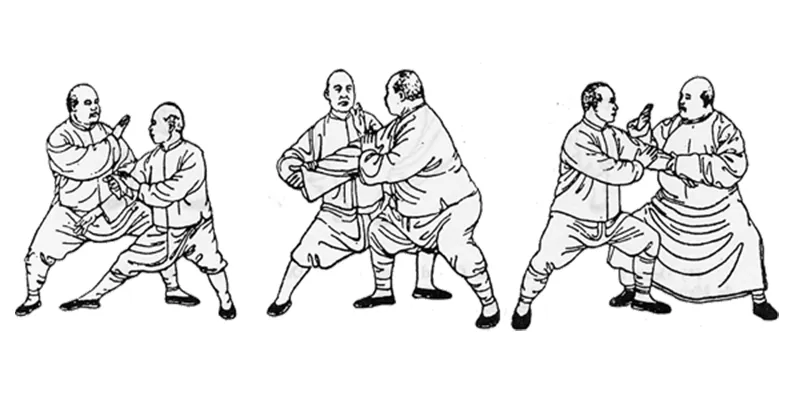
How it Works: You use your limbs as sensors to “listen” to your partner’s force, intention, balance, and root. You detect the direction, magnitude, and quality of their incoming force. This is a trained neurological skill, enhancing your proprioception and kinesthesia.
Your sensory receptors in the skin, muscles, and joints send data to your brain, which then processes it to build a real-time “map” of your partner’s structure and intent.
Yielding (or Neutralizing)
Once you “listen” and detect an incoming force, you do not meet it with opposing force. Instead, you yield or neutralize. This is the application of the Yin principle.
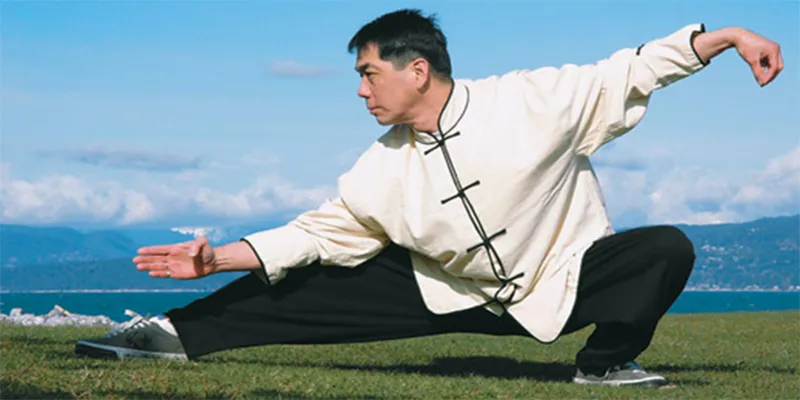
How it Works: By relaxing your joints and redirecting your center, you allow the incoming force to pass by you harmlessly. You are not collapsing or running away; you are creating space and dissolving the force’s point of application.
For example, if pushed directly, you might rotate your torso or take a subtle step back, causing your partner’s force to “slip” off its target and extend into emptiness.
This uses rotational mechanics and efficient weight transfer to redirect force directions. Instead of creating a high-impact collision, you guide the incoming force along a tangential path, much like a revolving door. This is incredibly efficient and requires minimal muscular strength.
Sticking and Adhering (Zhan Nian Jin)
Sticking does not mean breaking contact. The “sticking and adhering” energy is what keeps you connected to your partner as you yield. It’s a light, constant, and flexible connection.

How it Works: You maintain just enough pressure to stay “in touch” with your partner’s movements without pushing or resisting. This allows you to continue “listening” even as you neutralize. If you break contact, you lose the information stream and create an opportunity for your partner to readjust.
This constant connection turns your partner’s force and momentum against them. As they push into your yielding, neutral structure, they become overextended and unbalanced, creating a vulnerability.
Issuing Force (Fa Jin)
Once you have successfully yielded and uprooted your partner, you can then issue force. It is not a crude shove.
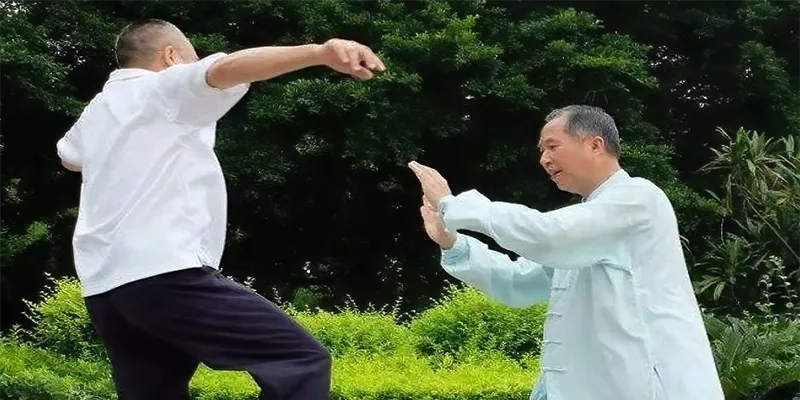
How it Works: Fa Jin is a short, explosive, and coordinated release of power generated from the ground, directed by the waist, and expressed through the limbs. It is a whole-body whip-like action, not an arm-powered push.
Because your partner is already unbalanced, even a small, well-timed Fa Jin can have a significant effect, propelling them away with minimal effort.
Power is generated from the large muscles of the legs and core, transferred efficiently through a relaxed body, and released in a rapid burst. The unbalancing of the opponent beforehand reduces the force required to uproot them, aligning with the physics of leverage.
Tai Chi Push Hands Mechanism
Mechanical Advantage
Tai Chi Push Hands operates like a human lever system. Your body acts as a series of interconnected levers, with joints as pivots. By aligning your structure optimally, you can multiply small movements into significant effects. For example:
The Elbow as a Fulcrum: By keeping your elbow relaxed and aligned, a slight rotation can redirect a strong push with minimal effort.
Center of Gravity Control: Unbalancing an opponent requires manipulating their center of gravity outside their base of support. Push Hands trains you to detect and exploit this instant.
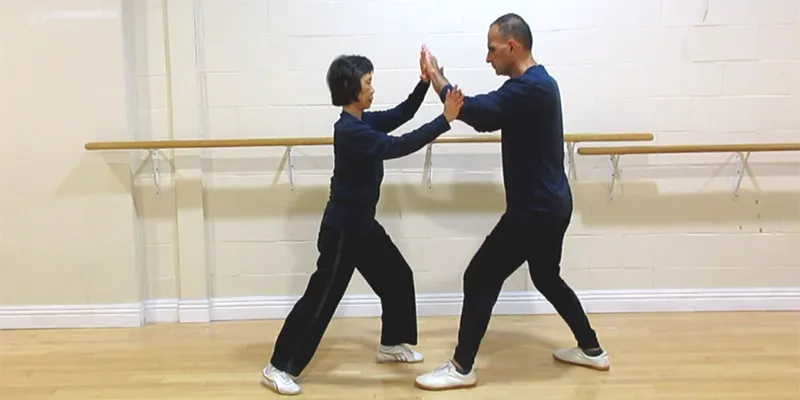
Neural Adaptation
Regular practice rewires the nervous system to replace rigid “fight-or-flight” reflexes with fluid, adaptive responses. This is why seasoned practitioners appear to move effortlessly—their reactions become subconscious and efficient.
Dynamic Balance
Studies of balance show that tai chi push hands enhances proprioception (awareness of body position) and postural control. The constant required to maintain stability under pressure improves coordination and reduces fall risk, especially in older adults.
Benefits of Practicing Tai Chi Push Hands
Enhanced Body Awareness and Coordination: The continuous, circular patterns improve whole-body coordination, training the arms, waist, and legs to move as a unified whole.
Improved Balance and Stability: The constant threat of being uprooted forces the development of a strong root and a low center of gravity.
This balance is dynamic, teaching you to maintain stability while in motion, which is invaluable for fall prevention, especially in older adults.
Deepened Understanding of Tai Chi Principles: You cannot truly understand concepts like “substantial and insubstantial” or “using four ounces to deflect a thousand pounds” by only practicing the form.

Tai Chi Push Hands provides the experiential knowledge that makes these abstract principles tangible.
As Professor Cheng Man-ch’ing emphasized, “I trust the ancients and their belief in the intrinsic indivisibility of form and function.”
How Do You Practice Tai Chi Push Hands?
Single-Hand Fixed Patterns: Beginners start with simple, prearranged patterns using one hand. This ingrains the basic mechanics of yielding, sticking, and shifting weight.
Double-Hand Fixed Patterns: Complexity increases with two-handed patterns, teaching coordination and how to handle multiple points of contact.
Freestyle Push Hands: Practitioners move beyond patterns and begin to apply the principles spontaneously. This is where “listening,” “neutralizing,” and “issuing” become reactive and intuitive.
Moving Step and Da Lu: Footwork is incorporated, training how to yield and attack while in motion, further enhancing balance and coordination under dynamic pressure.
Conclusion
Tai Chi Push Hands is far more than a martial arts drill; it is a practical philosophy in motion. It teaches that true strength lies not in domination, but in adaptation, awareness, and harmony.
Push Hands is one of continuous learning, offering endless depth for those willing to “listen.”

